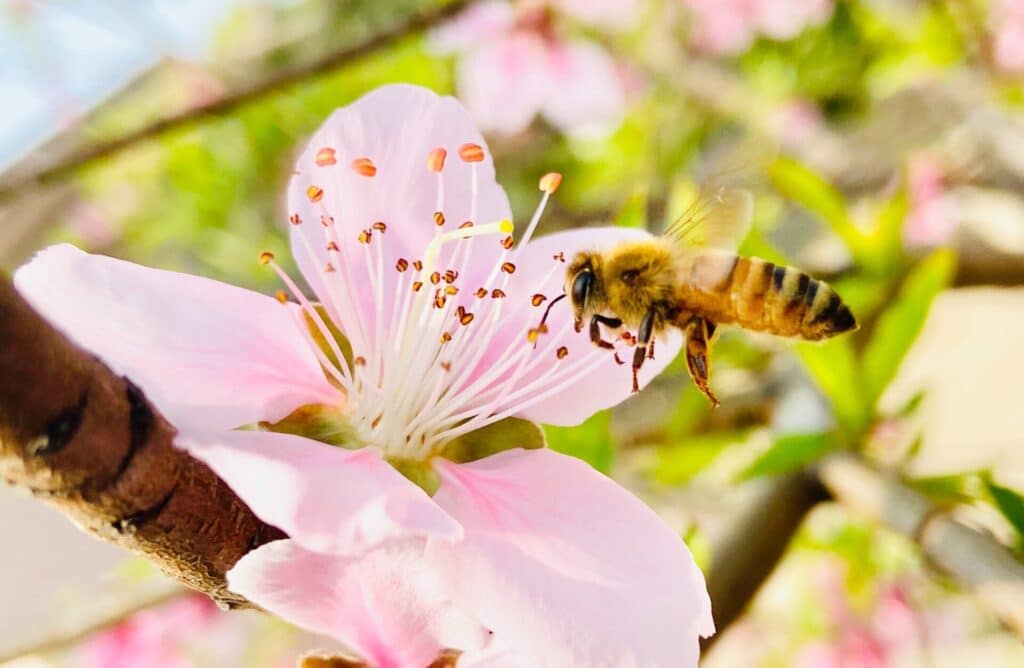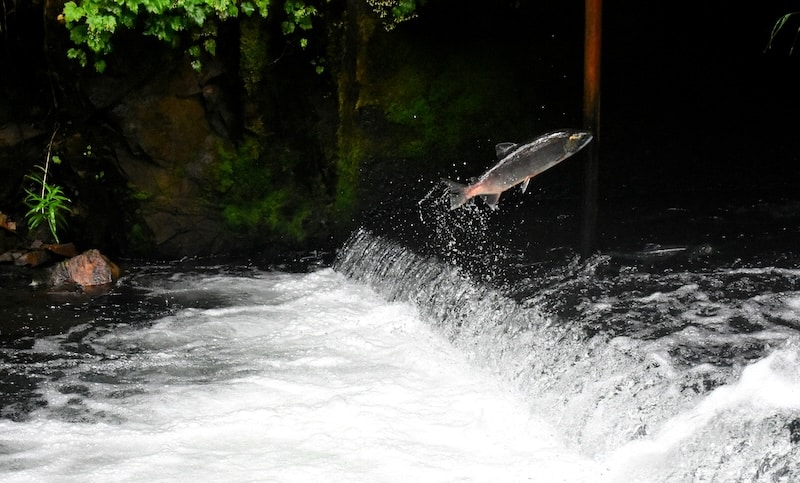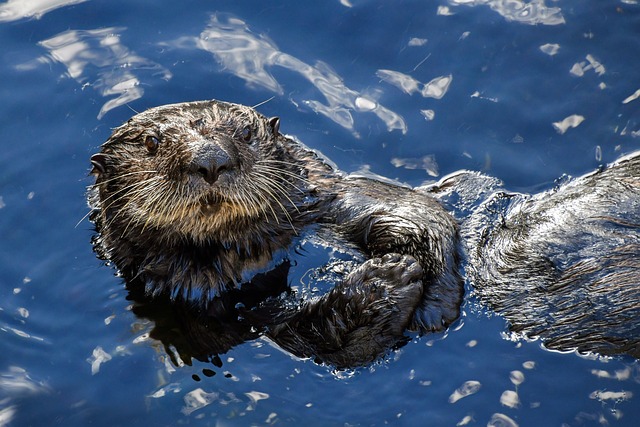Contents:
- What is an Indicator Species?
- Characteristics of an Indicator Species
- What is a Keystone Species?
- Types of Keystone Species
- Indicator Species vs Keystone Species
- Honey Bees as Both an Indicator Species and a Keystone Species
- Why are Indicator Species and Keystone Species Important?
- Examples of Indicator Species and Keystone Species
- FAQs
What is an Indicator Species?
An indicator species is one that reflects the condition of the environment around it. These can be bacteria, plants, or animal species, and they’re often the first in their ecosystem to be affected by environmental change. Indicator species are also known as bioindicators – because they can be easily observed, so they are often used as the focal point for researchers studying climate change and the anthropogenic effect on the environment.
Specific factors, such as reproduction rates, size, lifespan, density, and growth, can be monitored to reveal patterns over time. These patterns allow insight into the stress on the species from influences like pollution, habitat loss, and climate change. They can help us monitor and assess the health of their environment, as well as predict future changes.
Characteristics of Indicator Species
To be an effective indicator species, a species should have some key characteristics. These include:
- Its response to changes is relatively quick and easy to measure
- It heavily relies on ecosystem health to thrive and reproduce
- It should be relatively common and have a population big enough to easily study
- Its health should be indicative of the health of other species; a species that is uniquely vulnerable would make a poor bioindicator
What is a Keystone Species?
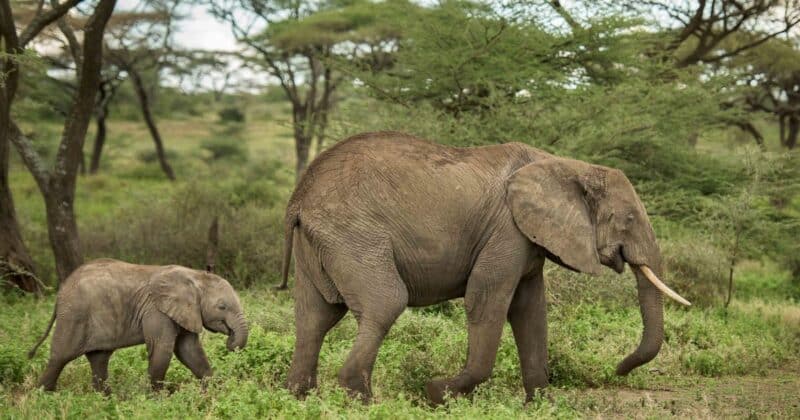
Keystone species are those that have a disproportionately large effect on the communities in which they occur. They help maintain biodiversity and there are no other species in the ecosystem that can serve their same function. Without them, their ecosystem would dramatically change, suffer, or even cease to exist.
Keystone species are believed to be found in all the world’s major ecosystems. Identifying these species can be challenging because doing so requires a complex knowledge of the interaction of all species within an ecosystem. However, it is essential to understanding how the loss of species will affect an ecosystem’s condition.
Types of Keystone Species
Because there are different ways that species can be integral to the functioning of their ecosystem, keystone species fall into several broad categories:
Predator
By keeping the populations and range of their prey in check, keystone predators impact other predators as well as the whole rest of the food chain. Without keystone predators, the populations of the species they hunt would skyrocket, pushing out other organisms and reducing biodiversity.
Prey
Species that serve as a critical food source for a multitude of other species are known as keystone prey. Additionally, not only do these species feed many others, but they are able to maintain healthy populations, despite being preyed upon by multiple predators.
Ecosystem Engineer
Ecosystem engineer species create, modify, or maintain the environment around them. They influence the prevalence and activities of other organisms and help maintain the overall biodiversity of their habitat.
Mutualists
Keystone mutualists are two or more species that engage in reciprocally vital interactions; the disruption of one species impacts the other and, ultimately, the ecosystem as a whole.
Indicator vs Keystone Species
Indicator species differ from keystone species, although some can be both. While keystone species are vital to sustaining their ecosystem, they may not be uniquely susceptible to environmental change – a key characteristic of indicator species. On the other hand, a species that is an effective bioindicator may not have a disproportionately large and irreplaceable impact on their communities.
Honey Bees as Both an Indicator Species and a Keystone Species
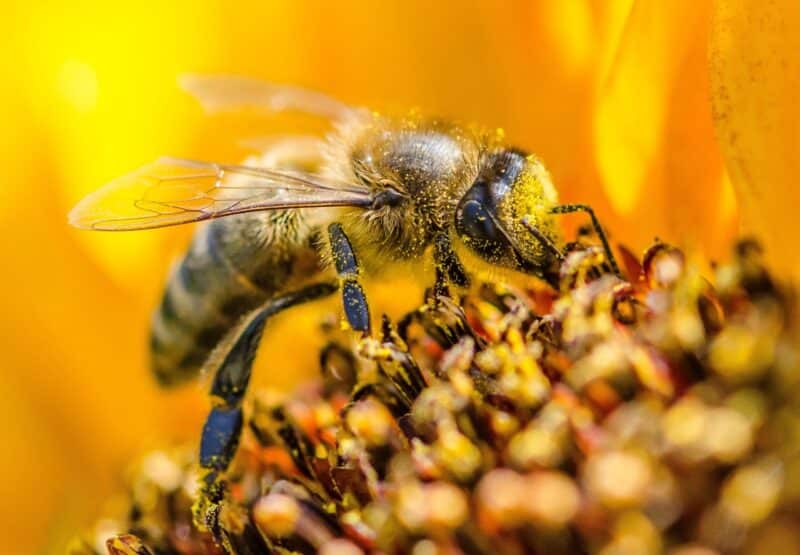
Honey Bees as an Indicator Species
Some of the aforementioned key characteristics of an indicator species don’t have anything to do with their responsiveness to environmental change, but rather their capacity to be studied. Honey bees are managed by humans around the world, and they are easily studied and monitored. Individual bees are vulnerable to environmental stressors, but the honey bee colony as a whole is more resilient and can respond to stressors without collapsing. This allows for long-term monitoring, which means we can map environmental changes in an area as well as study them over time.
The honey bee, being covered in tiny hairs, is a highly effective accumulator of materials from the soil, vegetation, air, and water in its environment. This makes honey bees important detectors of environmental pollution. They show evidence of environmental pollution or degradation in two easily measurable ways: mortality rates, cognitive functioning, and/or birth defects will increase, or toxic residue will be present in the honey, wax, and stored pollen.
Honey bees can also serve as indicators of climate change. Increasing global temperatures negatively affect honey bee thermoregulation and disrupt the colony’s growth and survival. Additionally, extreme temperatures and weather variability affects the plant resources that the bees forage from. Reduced flowering periods, a side-effect of global warming, decrease the nectar and pollen available to the bees.
At Best Bees, we’ve pioneered the process of identifying the exact percentage of various pollen species found in honey through advanced genomic sequencing. This provides insight into the presence of invasive species, the native plant population, and the biodiversity of the environment.
Native bees are typically solitary in nature; this makes them difficult to study and monitor reliably. Honey bees serve as indicators of pathogens affecting other bee species, because bee diseases can spread between species of wild and managed pollinators when healthy bees forage on plants that have been visited by infected bees of the same or different species.
Honey Bees as a Keystone Species
Honey bees are a keystone species in that, with the aid of other pollinators, they support the reproduction of 80% of the world’s flowering plants. They are also the world’s most important single species of pollinator in natural ecosystems and a key contributor to natural ecosystem functions.
Without honey bees, there would be a bottom-up cascade of consequences throughout the food chain. They ensure the continued reproduction and survival not only of the plants they pollinate but also of the other organisms that depend on those plants for survival.
When categorizing a keystone species, we look at the interactions between the species in question and its broader community. Honey bees fall under the mutualist category, as animal-pollinated plants rely on honey bees for fertilization and honey bees rely on the plants for pollen and nectar. Without this interaction, the food web would be simplified as plant species and bee species died off. Consequently, the biodiversity of their ecosystems would plummet, eventually leading to drastic change and even destruction.
Why are Indicator and Keystone Species Important?
By studying indicator species, we can stay updated on an ecosystem’s health without having to spread monitoring resources thin across multiple species and locations. This allows us to conserve our resources, maximizing our capacity for additional research and conservation efforts.
Additionally, indicator species can help us zero in on what change(s) is occurring in the environment. For example, while a wetland ecosystem may show general signs of degradation, if frog populations are plummeting, we know to look for increased levels of pesticides and other water pollutants.
Indicator species can help indicate the status of an environmental condition, find a disease outbreak, monitor pollution and climate change, and aid in predicting future changes in the environment. Because of their sensitivity to environmental change, they serve as a crucial ‘early warning system’ for scientists, conservationists, and ecologists.
Keystone species, because of their outsized impact on their surrounding environment, are critically important to the conservation of healthy ecosystems. Conservation and protection efforts need to prioritize these species because in their absence, their communities and ecosystems would suffer and even cease to exist.
Examples of Indicator and Keystone Species
Three Species that are both Indicator and Keystone Species:
1. Coral
The rocky exoskeletons of thousands of coral polyps create coral reefs, which are one of the most vibrant and biologically diverse ecosystems on the planet. Coral reefs provide habitat for thousands of marine species, making them an ecosystem engineer keystone species. Coral is also an indicator species, serving as an indicator of marine processes such as siltation, seawater rise, and sea temperature fluctuation.
2. White Ash Tree
The white ash tree is a bioindicator of increasing levels of invasive species, specifically the emerald ash borer. White ash trees are also a keystone species; they provide food and habitat to dozens of animal species and act as a sponge for air pollutants.
3. Honey Bees
Without the essential ecosystem service – pollination – that bees provide, not only would many plants be unable to reproduce, but the other organisms that need those plants to survive would suffer. This makes honey bees a mutualist keystone species. They are also an indicator species, as they are sensitive to environmental changes, reflect the conditions of their environment, and are easily monitored and studied.
Eight Examples of Indicator Species:
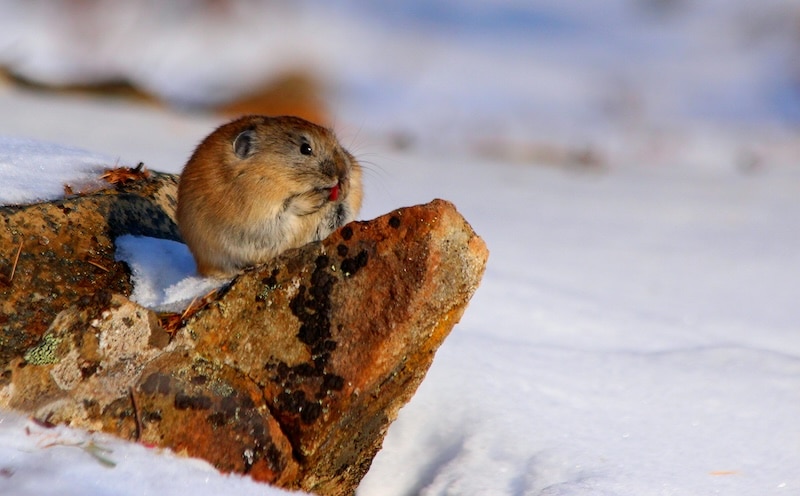
1. Pikas:
Pikas – small, furry mammals that look like short-eared rabbits – are perfectly adapted to living in harsh high-alpine habitats.To get through the winter, pikas take cover under rocky debris, relying on the insulation of heavy snow cover to keep their dens warm. Declines of pika populations indicate the presence of global warming; shorter winters and less snowfall reduces that insulating blanket of snow cover. Resultantly, the pikas are increasingly exposed to cold temperatures at a time when their food stores are depleted and their offspring are small and vulnerable.
2. Lichen:
Did you know lichens are a combination of a fungus and algae growing together in a symbiotic relationship? Lichens are used as bioindicators because of their sensitivity to air pollution, especially nitrogen pollution.
3. Spotted Owls:
These owls do not build their own nests, so they rely on mature old-growth forests for shelter and nesting materials. A decline in spotted owl populations indicates further declines in the quality of old-growth forests.
4. Salmon:
The migratory habits of salmon make them vulnerable to environmental changes, such as habitat destruction, damming of rivers, and an increase of pollution. When a river ecosystem is not clean or well-connected, its salmon population will usually decline.
5. Amphibians:
Freshwater frogs and toads have permeable skin through which they absorb oxygen, which means they are very sensitive to changes in water quality. Thus, they can provide early warnings of increased pollution, growth of invasive species, new pests and pathogens, and other changes in environmental conditions.
6. Crustaceans:
Oysters, clams, mussels, and other shellfish act as nature’s water filtration system. Ecologists test these organisms for heavy metals, pesticides, and plastics to monitor the effects of agricultural runoff and other water pollution issues. Crustaceans can also provide indications of the alkalinity or acidity of large bodies of water.
7. Bats:
Bats are nocturnal seed spreaders, pollinators, and insectivores, and their small size, high mobility, and wide distribution allows them to respond to environmental disturbances in measurable ways. They are also sensitive to human-induced changes in climate and habitat quality. Bats have been used by researchers to study light pollution, heavy metals, urbanization, and climate change.
8. River Otters:
In their freshwater aquatic ecosystems, river otters are considered apex predators. Any toxins in their environment make their way to the otters through the fish and invertebrates that they eat. Since toxins build up as they make their way up the food chain, river otters receive larger amounts of toxins than other animals in the same ecosystem; they show signs of toxin exposure before any other plant or animal. Consequently, river otters are valuable indicator species for monitoring the health of marine and freshwater habitats.
Eight Examples of Keystone Species:
1. Sea Otters: Predators
Sea otters significantly shape their communities by preying on sea urchins. Without the otters, sea urchins will grow in number and eat up the kelp forests that many other species depend on for habitat or food. Sea urchins can eat kelp at a rate of up to 30 feet per month, leaving barren sea floor in their wake. Luckily, sea otters are champion eaters, consuming up to 25% of their body weight daily – and sea urchins are their favorite food.
2. Gray Wolves: Predators
In 1995, gray wolves were reintroduced to Yellowstone National Park after an absence of some 70 years. After the return of the wolves, the elk population started to fall. With fewer elk grazing, the grass, shrubs, and trees grew. Willow and cottonwood trees returned to riverbanks, helping to stabilize these riparian zones and lessen erosion. More insects, then, fell from overhanging stems to feed the fish and amphibians. Beavers got more material for their dams, which in turn created habitats for fish, reptiles, and other animals.
3. African Elephants: Ecosystem Engineers
Elephants uproot and eat vast quantities of trees and shrubs, maintaining the sunny, open savanna where grasses can thrive. This vegetation supports other herbivores like antelopes, wildebeests, and zebras; it also provides warm, dry soil for smaller animals to burrow into. They also create watering holes for other animals and disperse plant seeds through their waste.
4. Beavers: Ecosystem Engineers
The dams beavers construct flood the surrounding landscape and form a wetland habitat that can support a richly diverse ecosystem. Freshwater fish, insects, amphibians, birds, other animals, and plants rely on wetlands for shelter, nursery habitat, and breeding and feeding grounds. Beaver dams and the wetlands they create also improve water quality in streams, replenish underwater aquifers, alleviate drought and water shortages, reduce flooding, store nutrients for plants, and reduce erosion of stream banks by slowing the flow of water.
5. Prairie Dogs: Ecosystem Engineers
In addition to serving as an important food source for many of their environment’s predators, prairie dogs are ecosystem engineers, maintaining the health of grasslands by churning, aerating, and fertilizing the soil as they create their underground colonies. This allows an array of vegetation to thrive, which feeds herbivores in their ecosystem, and their burrows provide shelter for animals like snakes, burrowing owls, and rabbits.
6. Hummingbird: Mutualists
In Patagonia, a specific species of hummingbird, the green-backed firecrown, pollinates 20% of the local plant species. The plants have evolved to only be pollinated by the green-backed firecrown, and they provide the hummingbirds with the sugary nectar that makes up the birds’ diet.
7. Antarctic Krill: Prey
Krill are a vital food source for a myriad of marine species, including whales, seals, penguins, and seabirds in Antarctica. Krill feed on phytoplankton and zooplankton, making essential nutrients available to the other animals for which krill makes up the largest part of their diet. For some animals in the Antarctic, almost all of their caloric intake comes from eating krill.
These tiny organisms also play an important role in the Southern Ocean’s biological cycling of nutrients. After feeding on algae that has absorbed atmospheric carbon dioxide at the sea surface, krill migrate to deep water to excrete their waste, thereby transferring large amounts of carbon to the ocean depths.
8. Snowshoe Hare: Prey
In boreal Canada, the snowshoe hare is a critical food source for many of the ecosystem’s predators – coyotes, foxes, at least 10 species of hawks and owls and the threatened Canada lynx. The populations of the Canada lynx are intimately tied to that of the snowshoe hare, as the lynx relies on the hares for more than 75% of its winter diet. Snowshoe hares also influence vegetation patterns and overall ecosystem biodiversity.
FAQs
Q: What is an indicator species?
A: An indicator species is one that reflects the health of its ecosystem and can be studied to monitor environmental conditions and changes.
Q: What is a keystone species?
A: A keystone species is one that has a disproportionately large impact on its surrounding communities.
Q: Are honey bees an indicator species?
A: Yes; honey bees reflect the health of their environment, are sensitive to environmental changes, and are easily studied and monitored.
Q: Are honey bees a keystone species?
A: Yes; honey bees ensure the continued survival of not just the plants they pollinate but also of all the other organisms that rely on those plants for survival.


